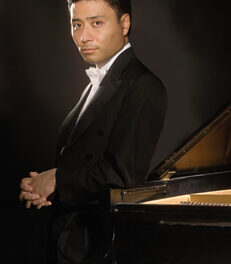Conductor Alfred E. Sturgis‘ “Chamber Choir” of forty voices (quotes used only because the term “Chamber” is relative to the size of the rooms in which that group may be expected to perform) closed the NC Master Chorale‘s 2018-19 season with simply beautiful singing in the welcoming acoustic of Raleigh’s Hayes Barton United Methodist Church.
The program, entitled “Till We Meet Again,” encompassed 19 works focusing on texts dealing in one way or another with the human experience of death and its aftermath. As Sturgis pointed out in his verbal commentary, this collection of thoughts was not intended to bring sadness, although that might be a legitimate response; rather, it was to share the writings of many poets about this universal experience, through the lenses of composers from the 19th century through our own time.
The concert began with the choir’s processing from the rear of the nave to a single-file semi-circular position across the front and extending a third of the way into each side aisle: “surround sound,” as it were. This performance technique, as I pointed out in previous reviews of a British college choir which utilizes it, has its best effect for those in the audience who are seated closest to the center of the room; those seated closest to the side aisles will, of course, hear more of the individual voices positioned only a few feet from them. The choir sang the oldest work on the program: Robert Pearsall’s (1795-1856) “Lay a garland,” from Beaumont and Fletcher’s play The Maid’s Tragedy. The choral sound was opulent, the diction impeccable – qualities which would remain throughout the hour of music. This is a singing group comparable in size to many university touring choirs, but with more mature voices. Their blend is excellent; no individual voices protrude.
Moving to the choral risers set up in the front of the sanctuary, the choir sang the only extended work of the evening: four movements of C. Hubert H. Parry’s Songs of Farewell. Written in the last years of his life, Parry’s settings of “end-time” texts by Henry Vaughan, Thomas Campion, John Lockhart, and from Psalm XXXIX (the texts by John Donne and John Davies were omitted) showed that his powers as a composer were not diminished by time and illness. Only in the final two chords of “My Soul, There is a Country” did we hear a fortissimo which pushed towards harshness; from then on, the choir’s sound was superb, in both quiet (such as the repetitions of the word “eternal” in “There is an Old Belief”) and loud passages. The choir reset from their quartet formation on the risers to a double-chorus formation for the concluding Parry work, “Lord, Let Me Know Mine End.” It is not surprising that Parry chose this text from Psalm XXXIX to conclude his Songs of Farewell, as he was an ardent admirer of the music of Johannes Brahms, who included some of the same text in the third movement of his “German Requiem.” The beginning and end of the passage Parry chose summarize a central thesis of this concert:
Lord, let me know mine end and the number of my days, that I may be certified how long I have to live. …O spare me a little, that I may recover my strength before I go hence and be no more seen.
Appropriately, Sturgis chose to follow this with music of Brahms, a folk-song-like setting of August Kretzchmer’s “Abschieslied” which talks of a lover’s thoughts on having to leave his beloved for a while. This was followed by another kind of farewell, with Mendelssohn’s setting of a text describing the sadness of birds who must, at summer’s end, “fly far away into distant lands.” The choir’s German diction was as fine as their English, every word clearly enunciated.
Closing the program’s first half, the choir was joined by pianist Susan McClaskey Lohr in Molly Ijames’ setting of Alfred, Lord Tennyson’s “A Farewell.” Lohr, the Master Chorale’s long-time collaborative pianist, is one of Raleigh’s musical treasures. She is fluent in any pianistic style, from classical (some two years ago, Beethoven’s Choral Fantasy, with its piano concerto-like demands) to gospel and musical show-tunes. Her playing is not only note-perfect, but always inspired and inspiring to audiences. The poet’s references to “rivulet” and “a thousand suns” found their musical paintings in Lohr’s playing.
Following intermission, the choir sang works of a lighter musical character: traditional hymns and folk tunes, spirituals, an Irish sea shanty sung by the tenors and basses, and selections from The Sound of Music (“So Long, Farewell”) and The Lion King (“Shadowland”). The choir and several soloists essayed all these with stylistic aplomb. (The sea shanty’s refrain “O Jenny get your oatcake done” brought on one of Sturgis’ [in]famous puns. Referring to the evening’s theme, “Till We Meet Again,” he said that the shanty’s refrain announced a theme for next season: “Till We Eat Again.” Good-natured groans from the audience ensued.
Two non-performance comments: [1] When a program contains so many works, each one lasting only a few minutes, it would be good to present the works in groups of three to four selections so applause does not interrupt the singing after each single number. Not that each of the Chamber Choir’s performances was not worthy of applause, but having to reset the mood some fifteen times is disturbing to the music’s natural flow and the program’s progression. [2] Written program notes would be helpful better to acquaint the audience with interesting facts about the music, its composers, and the authors of its texts.
Congratulations to Sturgis, Lohr, and the entire Chamber Choir for a thought-provoking program and for truly beautiful singing and playing.












